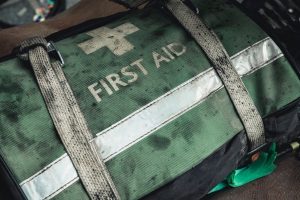Be winter-ready with your emergency kit and food

Last autumn, the National Weather Service predicted a wetter, colder winter in the Northwest, with the potential for bigger snowstorms. And that means a higher chance of power outages, flooding, a cold house, being snowed in or getting stuck on the roads.
All of which leads to one question: are you ready?
Start by thinking in threes: Pull together a three-day supply of food and water. Follow the suggestion of government agencies and prepare three emergency kits—one at home, another at work and another in your car. Finally, put together a family communication and meeting plan.
What should be in your emergency kits?
Among other items, emergency kits should include:
- Water—one gallon per person, per day
- Food and can opener—three or more days’ supply of non-perishable, ready-to-eat food
- News and weather radios—either battery powered or hand crank
- Flashlight and extra batteries
- First aid kit
- Antiseptic towelettes and toilet paper
- Plastic trash bags (for garbage or biological waste)
- Thermal emergency blankets
- Rain ponchos, warm clothes, hats, gloves, sturdy shoes
- Basic toiletries such as toothbrush, toothpaste, feminine supplies, towel
- Cash
- Prescription medications
- Supplies for babies (diapers/wipes, formula, baby food)
- Box of stick matches
- Pet supplies (food, litter supplies)
In your car, consider including flares, maps, chains, a shovel and blankets. A good length of rope (100 feet) can also prove useful in whiteout conditions; tie the rope to the car and your waist so that you can get back to the car. At home or work, consider installing a carbon monoxide detector and preparing a list of utilities’ phone numbers.
Now is the time to plan ahead! Set aside an evening or weekend morning. Get the whole family involved. Then later this winter, if you find yourselves in the dark and cold, you’ll be glad you planned ahead.
Additional resources—including access to more thorough checklists—are provided at the end of this article.
What should you keep in your pantry?
With our stormy Northwest weather, keep your pantry filled with easy-to-use, “no-cook” supplies that provide protein, fluids and essential nutrients. Government emergency management offices recommend having enough supplies for 72 hours.
Have plenty of no-cook foods on hand:
- Ready-to-eat cereal
- Canned or Tetra Pak milk
- Whole grain crackers
- Peanut butter or other nut butter
- Tuna and chicken salad in foil pouches
- Jello and pudding cups
- Fruit cups (or canned fruit)
- Graham crackers
- Canned juices
- Protein bars (such as Zone, Balance, Lara, Luna or Cliff)
- Canned pet food
Create no-cook menus ahead of time:
- Breakfast: cold cereal with canned milk and juice
- Snack: graham crackers with peanut butter and canned fruit
- Lunch/dinner: tuna or peanut butter and jelly sandwiches and canned fruit
- Snack: a protein bar
Where can you get more information?
When you create your emergency kits, follow a checklist to be sure you don’t forget a key item. You might also consider portability—can you quickly gather and carry your household supplies to the car, should you need to evacuate? If you’re in your car, can you load supplies on your back should you need to walk?
Take Winter by Storm
Offers preparedness checklists in nine languages, and links to information about weather, flooding, landslides, road conditions, utilities and human services.
Organized by City of Seattle, King County, Puget Sound Energy, and State Farm
Regional Flood Preparedness
Offers flood preparedness checklist, instructions for sandbags, links to emergency-alert services and information about evacuation routes, warming shelters and flood insurance.
Organized by King County


